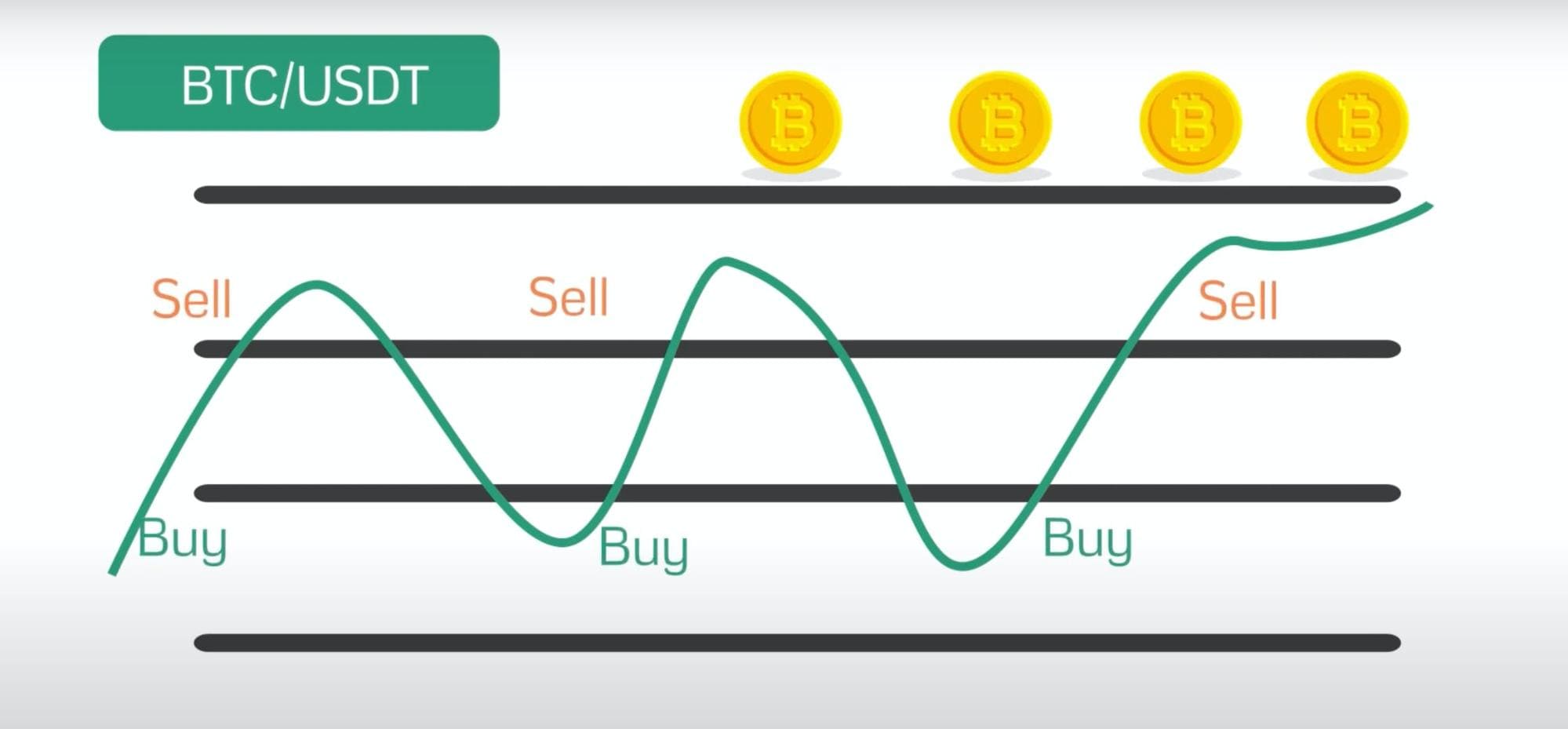Introduction
Welcome to the world of grid trading. In the volatile world of financial markets, traders are constantly seeking new and innovative ways to maximize their profits while minimizing their risks. One such strategy that has gained popularity in recent years is grid trading.
Grid trading is a technique that aims to take advantage of market price fluctuations by placing a series of limit orders at predetermined levels above and below the current market price. These orders create a grid-like structure of buy and sell orders, hence the name “grid trading.”
The concept of grid trading is based on the idea that markets tend to oscillate within a range, frequently moving up and down. By setting up a grid of orders, traders can potentially profit from these oscillations by capturing small but frequent gains.
This approach is often favored by traders who are looking for a more mechanical and systematic approach to trading, as it relies on preset rules and eliminates the need for subjective decision-making. Grid trading can be applied to various financial instruments, including stocks, commodities, forex, and cryptocurrencies.
However, it’s important to note that grid trading is not without its risks. While it can be an effective strategy in certain market conditions, it may not perform well in highly trending or volatile markets. Traders must carefully assess market conditions and adjust their grid settings accordingly.
In this article, we will delve into the world of grid trading, exploring how it works and examining its advantages and disadvantages. We will also provide some strategies and tips to help you get started with grid trading and increase your chances of success.
So, whether you’re a seasoned trader looking to diversify your portfolio or a beginner exploring different trading strategies, join us as we unravel the intricacies of grid trading and discover if it’s the right fit for you.
Definition of Grid Trading
Grid trading is a trading strategy that involves placing a series of buy and sell orders at pre-determined price levels above and below the current market price. These orders create a grid-like structure on a price chart, hence the name “grid trading.” The main idea behind this strategy is to profit from the market’s tendency to oscillate within a specific range, capturing small gains from frequent price fluctuations.
Grid trading is based on the concept of capturing profits at regular intervals while ensuring limited exposure to market risks. Traders who employ this strategy typically set up the grid by placing multiple buy stop and sell stop orders at regular intervals above and below the current market price. When the market price reaches one of these levels, the corresponding order is triggered, either buying or selling the asset.
Once an order is triggered, the grid trader would then set a take profit level for that order, usually at a pre-determined profit target. Additionally, a stop loss level may also be set to limit potential losses if the market moves against the trade. This stop loss level is typically placed at a fixed distance from the entry point.
Grid trading can be applied to various financial instruments, including stocks, commodities, forex, and cryptocurrencies. It is often used by traders who prefer a more mechanical and systematic approach to trading, as it eliminates the need for subjective decision-making and relies on pre-set rules.
It is important to note that there are different variations of grid trading, each with its own set of rules and parameters. For example, some traders may opt for a fixed grid, where the grid spacing remains constant. Others may choose a dynamic grid, where the grid adjusts based on market conditions or volatility.
Ultimately, the goal of grid trading is to accumulate small profits over time, taking advantage of the market’s natural oscillations while minimizing the impact of adverse price movements. However, traders should carefully analyze market conditions and adjust their grid parameters accordingly, as grid trading may not perform well in highly trending or volatile markets.
How Grid Trading Works
Grid trading operates on the principle of placing a series of buy and sell orders at predetermined price levels, creating a grid-like structure on the price chart. This strategy aims to profit from the market’s tendency to oscillate within a specific range, allowing traders to capture frequent small gains.
To implement grid trading, a trader sets up a grid by placing a set of buy stop and sell stop orders at regular intervals above and below the current market price. These interval levels are typically referred to as “grid lines.” When the market price reaches one of these grid lines, the corresponding order is triggered, either buying or selling the asset.
Once an order is triggered, the trader can set a take profit level for that order, which represents the desired profit target. Additionally, a stop loss level may also be set to limit potential losses if the market moves against the trade. This stop loss level is usually placed at a fixed distance from the entry point.
While grid trading allows for capturing profits from price fluctuations within the set grid, it is important to note that it is an ongoing strategy. As the market price moves, new grid lines are continuously added above and below the current price level to maintain the grid structure.
One critical aspect of grid trading is determining the spacing between grid lines. Traders can choose to have a fixed grid, where the spacing remains constant, or a dynamic grid, where the spacing adjusts based on market conditions or volatility. The grid spacing plays a vital role in determining the frequency of trades, potential profit targets, and overall risk management.
It is crucial to note that grid trading requires careful monitoring and adjustments. As the market evolves, traders need to assess whether the market conditions are suitable for grid trading. Highly trending markets or excessive volatility may lead to frequent stop-outs or compromised profitability. Therefore, traders should be prepared to adapt their grid settings accordingly to optimize their trading results.
In summary, grid trading involves placing a series of buy and sell orders at pre-determined price levels in a grid-like structure. Traders aim to profit from the market’s oscillations and capture small gains over time. It is a systematic strategy that requires careful grid parameter setting and continuous monitoring of market conditions to achieve optimal results.
Advantages of Grid Trading
Grid trading offers several advantages that make it an appealing strategy for traders looking to capitalize on market fluctuations. Here are some of the key benefits:
- Potential for consistent profits: Grid trading is designed to generate small but frequent profits. By capturing gains from price oscillations within the predetermined grid, traders have the opportunity to accumulate profits over time. This consistency can be appealing for traders who prefer a steady approach to trading.
- Systematic and rules-based approach: Grid trading relies on pre-set rules and parameters, eliminating the need for subjective decision-making. Traders can define their grid settings in advance, including grid spacing, take profit levels, and stop loss levels. This systematic approach helps eliminate emotions and potential errors that can arise from impulsive trading decisions.
- Provides flexibility in different market conditions: Grid trading can be adapted to various market conditions. Traders have the flexibility to adjust their grid spacing and parameters based on market volatility and trends. This adaptability allows traders to potentially profit in range-bound markets, as well as in markets experiencing mild or moderate trends.
- Ability to capture both buying and selling opportunities: Grid trading allows traders to capture gains from both upward and downward price movements. By setting up both buy and sell orders in the grid structure, traders can take advantage of market fluctuations in both directions. This flexibility enables traders to potentially profit regardless of the overall market direction.
- Potential risk management: Grid trading incorporates risk management elements through the use of stop loss levels. By setting a predetermined stop loss for each order, traders can limit potential losses if the market moves against their trades. This risk management aspect can provide a level of protection and help preserve capital.
While there are several advantages to grid trading, it is important to note that no trading strategy is without risks. Traders should always exercise caution, perform thorough analysis, and continuously monitor market conditions to make informed decisions and optimize their grid trading results.
Disadvantages of Grid Trading
While grid trading offers certain advantages, it is essential to consider its potential drawbacks before implementing this strategy. Here are some of the main disadvantages to be aware of:
- Potential for prolonged drawdowns: Grid trading operates on the assumption that the market will oscillate within a specific range. However, in trending or volatile markets, the price may break out of the grid structure, leading to prolonged drawdowns. This can result in multiple losing trades and a significant reduction in capital.
- Requires continuous monitoring: Grid trading requires meticulous attention to the market as traders need to adapt their grid settings based on the evolving market conditions. Failing to monitor and adjust the grid parameters can lead to losses or missed profit opportunities.
- Increased exposure to market risks: Grid trading involves having multiple open positions simultaneously. While this strategy aims to manage risks by using stop loss levels, the exposure to the market is higher compared to traditional trading methods. Sudden and significant price movements can result in increased losses if stop loss levels are not triggered in time.
- May lead to missed market opportunities: Grid trading operates on a predetermined grid structure, which means that trades are based solely on price levels. Traders may miss out on profitable opportunities that do not coincide with the grid lines. This can limit potential gains if the market experiences rapid or unpredictable price movements.
- Complexity in volatile markets: Highly volatile markets can pose challenges for grid trading. Rapid price fluctuations can trigger multiple orders in quick succession, resulting in increased trading costs and potential execution delays. Additionally, extreme market conditions can lead to wider spreads, which may impact the profitability of grid trades.
It is crucial for traders to recognize and understand the limitations and risks associated with grid trading. These disadvantages highlight the importance of diligent risk management, ongoing monitoring of market conditions, and careful adjustment of grid parameters to maximize the strategy’s effectiveness.
Strategies for Grid Trading
Grid trading offers various strategies that traders can employ to optimize their trading results. These strategies involve different approaches to grid parameter settings and risk management. Here are a few popular strategies:
- Fixed Grid Strategy: The fixed grid strategy involves setting a fixed grid spacing for the buy and sell orders. For example, a trader may set the grid spacing to 20 pips in a forex trading scenario. This strategy allows for consistent spacing between grid lines regardless of market conditions. Traders using the fixed grid strategy typically aim to capture smaller gains more frequently within the defined grid range.
- Dynamic Grid Strategy: The dynamic grid strategy adjusts the grid spacing based on market conditions or volatility. A trader may choose to widen the grid spacing in highly volatile markets to reduce frequency of trades and minimize the risk of being stop-out. Conversely, the grid spacing may be narrowed in calmer market conditions to capture more frequent trades within a tighter range. By tailoring the grid spacing to market conditions, traders aim to optimize profitability while managing risk.
- Trend-Following Grid Strategy: In this strategy, traders incorporate the direction of the trend into their grid trading approach. If the market is in an uptrend, traders may bias their grid orders towards the buy side, focusing on placing more buy orders. Conversely, if the market is in a downtrend, the strategy would involve placing more sell orders. This strategy aims to align grid trades with the prevailing trend, potentially maximizing profits during trending market conditions.
- Reversal Grid Strategy: The reversal grid strategy involves using grid trading to take advantage of market reversals. Traders place sell orders on grid lines above the current market price and buy orders on grid lines below the current market price. When the market reaches one of these grid lines, the trader aims to capture profits from the anticipated reversal. This strategy requires careful analysis of market conditions and reliable reversal signals.
It’s important to note that these strategies should be adapted and tailored to individual trading preferences, risk tolerance, and market conditions. Traders should perform thorough analysis, continuously monitor market dynamics, and adjust their grid parameters accordingly to maximize the effectiveness of their chosen strategy.
Tips for Successful Grid Trading
While grid trading can be a profitable strategy when implemented effectively, here are some tips to enhance your chances of success:
- Plan and define your grid parameters: Before entering any trades, carefully plan your grid parameters, including the spacing between grid lines, take profit levels, and stop loss levels. Consider market conditions, volatility, and risk appetite when determining these parameters.
- Monitor market conditions: Continuously observe market dynamics, trends, and volatility. Adjust your grid parameters as needed to align with the current market environment. Avoid trading during highly volatile or trending periods that may negatively impact grid trading results.
- Implement proper risk management: Set appropriate stop loss levels for each grid order to limit potential losses if the market moves against your trades. Consider your risk-reward ratio and overall portfolio risk when determining stop loss levels. Regularly assess your risk exposure and adjust position sizes accordingly.
- Do thorough analysis: Apply technical and fundamental analysis to identify potential support and resistance levels, market trends, and reversal patterns. Combining grid trading with sound analysis can help increase the effectiveness and success rate of your trades.
- Stay disciplined: Stick to your predefined grid parameters and trading plan. Avoid making impulsive decisions or deviating from your strategy based on emotions or short-term market fluctuations. Consistently follow your plan to maintain discipline and improve overall trading performance.
- Adapt and optimize: Regularly review and analyze your grid trading results. Identify areas for improvement and adjust your grid parameters accordingly. Consider experimenting with different variations of grid trading and continuously refine your approach based on real-time feedback.
- Keep a trading journal: Maintain a trading journal to record your trades, grid parameters, and the rationale behind each trade. Reviewing your journal can help you identify patterns, strengths, and weaknesses in your grid trading strategy, enabling you to make informed adjustments and improvements.
- Practice risk diversification: Avoid overconcentration in a single asset or market. Diversify your grid trading portfolio by including multiple assets or markets to spread your risk. This can help mitigate the impact of adverse price movements in specific assets or sectors.
- Continuous learning and improvement: Never stop learning and stay up to date with market developments and new trading strategies. Engage in educational resources, forums, and discussions to expand your knowledge and enhance your grid trading skills.
By implementing these tips, you can enhance your grid trading approach and increase your chances of successful and profitable trades. Remember, consistency, adaptability, and disciplined execution are key factors in achieving long-term success with grid trading.
Conclusion
Grid trading is a trading strategy that aims to profit from the market’s oscillations within a predetermined range. By placing a series of buy and sell orders at specific price levels, traders can capture small but frequent gains. This systematic approach to trading offers both advantages and disadvantages.
One of the key advantages of grid trading is its potential for consistent profits. This strategy provides traders with a systematic and rules-based approach, eliminating the need for subjective decision-making. It also offers flexibility in different market conditions, allowing traders to adapt their grid settings accordingly.
However, grid trading is not without its drawbacks. Traders must be aware of the potential for prolonged drawdowns, the need for continuous monitoring, and the increased exposure to market risks. Market opportunities may also be missed if they do not align with the predetermined grid lines.
To succeed in grid trading, traders should consider various strategies, such as fixed grids, dynamic grids, trend-following grids, and reversal grids. Implementing proper risk management techniques, performing thorough analysis, and maintaining discipline are crucial for success.
Ultimately, grid trading can be a viable strategy for traders looking for a systematic approach to capitalize on market fluctuations. By carefully planning and adjusting grid parameters, monitoring market conditions, and implementing effective risk management, traders can increase their chances of success.
As with any trading strategy, grid trading requires practice, continuous learning, and adaptability. Traders should constantly evaluate their results, seek improvement, and refine their approach based on real-time feedback.
So, whether you decide to embark on the grid trading journey or explore other trading strategies, always remember that success comes with careful analysis, proper risk management, and a disciplined trading approach.

























